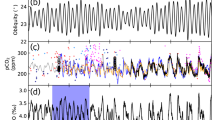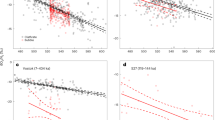Abstract
It is believed that during the Quaternary era changes in global ice volume were mainly due to changes in the size of the ice sheets on the Eurasian and American continents. Time spectra of oxygen isotope records from deep-sea cores and of the Earth's orbital parameters are remarkably similar in the 10,000–120,000-yr range1,2, suggesting that changes in global ice volume are forced by insolation variations. Model studies by Weertman3,4 and Pollard5 have confirmed this point to some extent: the 20,000- and 40,000-yr cycles can be reproduced, but the 100,000-yr cycle does not show up. Recently, Imbrie and Imbrie6 have fitted simple nonlinear mathematical models to δ18O curves. They found that reasonable fits are obtained if the time scale for ice-sheet growth is about 27,000 yr and for decay about 7,000 yr. The present study considers the problem of the 100,000-yr cycle in a similar way. Experiments with a Northern Hemisphere ice-sheet model show that the 100,000-yr cycle and its sawtooth shape may be explained by ice sheet/bedrock dynamics alone. This cycle seems to be an internally generated feature and is not forced by variations in the eccentricity of the Earth's orbit.
This is a preview of subscription content, access via your institution
Access options
Subscribe to this journal
Receive 51 print issues and online access
$199.00 per year
only $3.90 per issue
Buy this article
- Purchase on Springer Link
- Instant access to full article PDF
Prices may be subject to local taxes which are calculated during checkout
Similar content being viewed by others
References
Van den Heuvel, E. P. J. Geophys. J. R. astr. Soc. 11, 323–336 (1966).
Hays, J. D., Imbrie, J. & Shackleton, N. J. Science 194, 1121–1132 (1976).
Weertman, J. Nature 261, 17–20 (1976).
Weertman, J. J. geophys. Res. 78, 4463–4471 (1961).
Pollard, D. Nature 272, 233–235 (1978).
Imbrie, J. & Imbrie, J. Z. Science 207, 943–953 (1980).
Weertman, J. J. Glacial. 38, 145–158 (1964).
Oerlemans, J. Tellus (in the press).
Oerlemans, J. & Bienfait, J. M. in Proc. Sun and Climate Conf. (CNES, Toulouse, 1980).
Berger, A. L. J. atmos. Sci. 35, 2362–2367 (1978).
Kominz, M. A. & Pisias, N. G. Science 204, 171–173 (1979).
Imbrie, J., Van Donk, J. & Kipp, N. G. Quat. Res. 3, 10–38 (1973).
Author information
Authors and Affiliations
Rights and permissions
About this article
Cite this article
Oerlemans, J. Model experiments on the 100,000-yr glacial cycle. Nature 287, 430–432 (1980). https://doi.org/10.1038/287430a0
Received:
Accepted:
Issue Date:
DOI: https://doi.org/10.1038/287430a0
This article is cited by
-
High interstadial sea levels over the past 420ka from the Huon Peninsula, Papua New Guinea
Communications Earth & Environment (2022)
-
Research agendas in climate studies: the case of West Antarctic Ice Sheet research
Climatic Change (2014)
-
Solution proposed for ice-age mystery
Nature (2013)
-
Insolation-driven 100,000-year glacial cycles and hysteresis of ice-sheet volume
Nature (2013)
-
Exploration of a simple model for ice ages
GEM - International Journal on Geomathematics (2013)
Comments
By submitting a comment you agree to abide by our Terms and Community Guidelines. If you find something abusive or that does not comply with our terms or guidelines please flag it as inappropriate.



